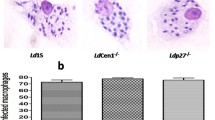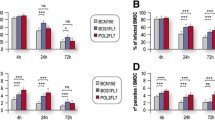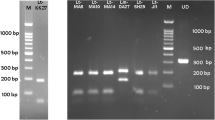Abstract
Leishmaniasis is a vector-borne parasitic disease caused by protozoa of the genus Leishmania. Twenty different species are known to cause disease in humans with varying degrees of pathology. These diseases are transmitted throughout the geographic range of phlebotomine sandflies, found between the latitudes 50°N and 40°S. This study explores antibody dependent enhancement (ADE) as the cause of disease exacerbation in heterologous exposure of L. major primed mice to L. infantum challenge. BALB/c mice received serum from L. major infected or naive mice. All mice were challenged with L. infantum and tissue parasite burdens were recorded. Animals that received anti-L. major serum exhibited significantly higher parasite burdens. Surprisingly, these parasite burdens were higher than those of mice infected with L. major and challenged with L. infantum. In vitro phagocytosis assays were carried out to measure parasite uptake in the presence of naive vs. anti-L. major serum. J774A.1 murine monocytes were cultured with either L. major or L. infantum in the presence of anti-L. major serum, naive serum, or no serum. Significantly higher rates of L. major uptake by J774A.1 cells occurred in the presence of anti-L. major serum, but no measurable increase of L. infantum phagocytosis was seen. Our results suggest that increased disease severity observed in vivo in mice previously exposed to L. major and challenged with L infantum is not a result of extrinsic ADE. We speculate that intrinsic ADE, due to biased memory T cell responses caused by Fcγ signaling, could account for disease exacerbation seen in the animal model.





Similar content being viewed by others
References
Aguilar-Be I, da Silva ZR, Paraguai de Souza E, Borja-Cabrera GP, Rosado-Vallado M, Mut-Martin M, Garcia-Miss M, Palatnik de Sousa CB, Dumonteil E (2005) Cross-protective efficacy of a prophylactic Leishmania donovani DNA vaccine against visceral and cutaneous murine leishmaniasis. Infect Immun 73:812–819. https://doi.org/10.1128/IAI.73.2.812-819.2005
Ahmed S, Colmenares M, Soong L, Goldsmith-Pestana K, Munstermann L, Molina R, McMahon-Pratt D (2003) Intradermal infection model for pathogenesis and vaccine studies of murine visceral leishmaniasis. Infect Immun 71:401–410. https://doi.org/10.1128/IAI.71.1.401-410.2003
Akhoundi M, Kuhls K, Cannet A, Votýpka J, Marty P, Delaunay P, Sereno D (2016) A historical overview of the classification, evolution, and dispersion of Leishmania parasites and sandflies. PLOS Neglect Trop D 10:e0004349
Alvar J, Vélez ID, Bern C, Herrero M, Desjeux P, Cano J, Jannin J, Boer M (2012) Leishmaniasis worldwide and global estimates of its incidence. PLoS One 7:e35671
Anderson CF, Gerber JS, Mosser DM (2002) Modulating macrophage function with IgG immune complexes. J Endotoxin Res 8:477–481. https://doi.org/10.1179/096805102125001118
Bardina SV, Bunduc P, Tripathi S, Duehr J, Frere JJ, Brown JA, Nachbagauer R, Foster GA, Krysztof D, Tortorella D, Stramer SL, García-Sastre A, Krammer F, Lim JK (2017) Enhancement of Zika virus pathogenesis by preexisting antiflavivirus immunity. Science 356:175–180. https://doi.org/10.1126/science.aal4365
Buchmüller-Rouiller Y, Mauël J (1986) Correlation between enhanced oxidative metabolism and leishmanicidal activity in activated macrophages from healer and nonhealer mouse strains. J Immunol 136:3884–3890
Buxbaum LU (2008) A detrimental role for IgG and FcgammaR in Leishmania mexicana infection. Immunol Res 42:197–209
Deak E, Jayakumar A, Cho KW, Goldsmith-Pestana K, Dondji B, Lambris JD, McMahon-Pratt D (2010) Murine visceral leishmaniasis: IgM and polyclonal B-cell activation lead to disease exacerbation. Eur J Immunol 40:1355–1368
Dey R, Natarajan G, Bhattacharya P, Cummings H, Dagur PK, Terrazas C, Selvapandiyan A, McCoy JP Jr, Duncan R, Satoskar AR, Nakhasi HL (2014) Characterization of cross-protection by genetically modified live-attenuated Leishmania donovani parasites against Leishmania mexicana. J Immunol 193:3513–3527. https://doi.org/10.4049/jimmunol.1303145
Dondji B, Pérez-Jimenez E, Goldsmith-Pestana K, Esteban M, McMahon-Pratt D (2005) Heterologous prime-boost vaccination with the LACK antigen protects against murine visceral leishmaniasis. Infect Immun 73:5286–5289
Dondji B, Deak E, Goldsmith-Pestana K, Perez-Jimenez E, Esteban M, Miyake S, Yamamura T, McMahon-Pratt D (2008) Intradermal NKT cell activation during DNA priming in heterologous prime-boost vaccination enhances T cell responses and protection against Leishmania. Eur J Immunol 38:706–719
Gicheru MM, Olobo JO, Anjili CO (1997) Heterologous protection by Leishmania donovani for Leishmania major infections in the vervet monkey model of the disease. Exp Parasitol 85:109–116. https://doi.org/10.1006/expr.1996.4117
Glennie ND, Volk SW, Scott P (2017) Skin-resident CD4+ T cells protect against Leishmania major by recruiting and activating inflammatory monocytes. PLoS Pathog 13(4):e1006349. https://doi.org/10.1371/journal.ppat.1006349
Gould EA, Buckley A (1989) Antibody-dependent enhancement of yellow fever and Japanese encephalitis virus neurovirulence. J Gen Virol 70:1605–1608
Heinzel FP, Sadick MD, Holaday BJ, Coffman RL, Locksley RM (1989) Reciprocal expression of interferon γ or interleukin 4 during the resolution or progression of murine leishmaniasis: evidence for expansion of distinct helper T cell subsets. J Exp Med 169:59–72
Heinzel FP, Sadick MD, Mutha SS, Locksley RM (1991) Production of interferon gamma, interleukin 2, interleukin 4, and interleukin 10 by CD4+ lymphocytes in vivo during healing and progressive murine leishmaniasis. P Natl Acad Sci USA 88:7011–7015
Kane MM, Mosser DM (2001) The role of IL-10 in promoting disease progression in leishmaniasis. J Immunol 166:1141–1147
Katzelnick LC, Gresh L, Halloran ME, Mercado JC, Kuan G, Gordon A, Harris E et al (2017) Antibody-dependent enhancement of severe dengue disease in humans. Science 358:929–932. https://doi.org/10.1126/science.aan6836
Kima PE (2007) The amastigote forms of Leishmania are experts at exploiting host cell processes to establish infection and persist. Int J Parasitol 37:1087–1096. https://doi.org/10.1016/j.ijpara.2007.04.007
Lozano R, Naghavi M, Foreman K, Lim S, Shibuya K, Aboyans V, Abraham J, Adair T, Aggarwal R, Ahn SY, AlMazroa MA, Alvarado M, Anderson HR, Anderson LM, Andrews KG, Atkinson C, Baddour LM, Barker-Collo S, Bartels DH, Bell ML, Benjamin EJ, Bennett D, Bhalla K, Bikbov B, Abdulhak AB, Birbeck G, Blyth F, Bolliger I, Boufous S, Bucello C, Burch M, Burney P, Carapetis J, Chen H, Chou D, Chugh SS, Coffeng LE, Colan SD, Colquhoun S, Colson KE, Condon J, Connor MD, Cooper LT, Corriere M, Cortinovis M, de Vaccaro KC, Couser W, Cowie BC, Criqui MH, Cross M, Dabhadkar KC, Dahodwala N, de Leo D, Degenhardt L, Delossantos A, Denenberg J, Des Jarlais DC, Dharmaratne SD, Dorsey ER, Driscoll T, Duber H, Ebel B, Erwin PJ, Espindola P, Ezzati M, Feigin V, Flaxman AD, Forouzanfar MH, Fowkes FGR, Franklin R, Fransen M, Freeman MK, Gabriel SE, Gakidou E, Gaspari F, Gillum RF, Gonzalez-Medina D, Halasa YA, Haring D, Harrison JE, Havmoeller R, Hay RJ, Hoen B, Hotez PJ, Hoy D, Jacobsen KH, James SL, Jasrasaria R, Jayaraman S, Johns N, Karthikeyan G, Kassebaum N, Keren A, Khoo JP, Knowlton LM, Kobusingye O, Koranteng A, Krishnamurthi R, Lipnick M, Lipshultz SE, Ohno SL, Mabweijano J, MacIntyre MF, Mallinger L, March L, Marks GB, Marks R, Matsumori A, Matzopoulos R, Mayosi BM, McAnulty JH, McDermott MM, McGrath J, Memish ZA, Mensah GA, Merriman TR, Michaud C, Miller M, Miller TR, Mock C, Mocumbi AO, Mokdad AA, Moran A, Mulholland K, Nair MN, Naldi L, Narayan KMV, Nasseri K, Norman P, O'Donnell M, Omer SB, Ortblad K, Osborne R, Ozgediz D, Pahari B, Pandian JD, Rivero AP, Padilla RP, Perez-Ruiz F, Perico N, Phillips D, Pierce K, Pope CA III, Porrini E, Pourmalek F, Raju M, Ranganathan D, Rehm JT, Rein DB, Remuzzi G, Rivara FP, Roberts T, de León FR, Rosenfeld LC, Rushton L, Sacco RL, Salomon JA, Sampson U, Sanman E, Schwebel DC, Segui-Gomez M, Shepard DS, Singh D, Singleton J, Sliwa K, Smith E, Steer A, Taylor JA, Thomas B, Tleyjeh IM, Towbin JA, Truelsen T, Undurraga EA, Venketasubramanian N, Vijayakumar L, Vos T, Wagner GR, Wang M, Wang W, Watt K, Weinstock MA, Weintraub R, Wilkinson JD, Woolf AD, Wulf S, Yeh PH, Yip P, Zabetian A, Zheng ZJ, Lopez AD, Murray CJL (2012) Global and regional mortality from 235 causes of death for 20 age groups in 1990 and 2010: a systematic analysis for the Global Burden of Disease Study 2010. Lancet 380:2095–2128. https://doi.org/10.1016/S0140-6736(12)61728-0
Lum FM, Couderc T, Chia BS, Ong RY, Her Z, Chow A, Ng LF (2018) Antibody-mediated enhancement aggravates chikungunya virus infection and disease severity. Sci Rep-UK 8:1860. https://doi.org/10.1038/s41598-018-20305-4
Macura N, Zhang T, Casadevall A (2007) Dependence of macrophage phagocytic efficacy on antibody concentration. Infect Immun 75:1904–1915. https://doi.org/10.1128/IAI.01258-06
Malchiodi EL, Chiaramonte MG, Taranto NJ, Zwirner NW, Margni RA (1994) Cross-reactivity studies and differential serodiagnosis of human infections caused by Trypanosoma cruzi and Leishmania spp; use of immunoblotting and ELISA with a purified antigen (Ag163B6). Clin Exp Immunol 97:417–423
Mandell MA, Beverley SM (2017) Continual renewal and replication of persistent Leishmania major parasites in concomitantly immune hosts. PNAS 114(5):E801–E810. https://doi.org/10.1073/pnas.1619265114
Manson-Bahr PEC (1961) Immunity in Kala-Azar. T Roy Soc Trop Med H 55:550–555. https://doi.org/10.1016/0035-9203(61)90078-5
Markle WH, Makhoul K (2004) Cutaneous leishmaniasis recognition and treatment. Am Fam Physician 69:1455–1460
Mathers CD, Ezzati M, Lopez AD (2007) Measuring the burden of neglected tropical diseases: the global burden of disease framework. PLoS Neglect Trop D 1:e114. https://doi.org/10.1371/journal.pntd.0000114
Miles SA, Conrad SM, Alves RG, Jeronimo SM, Mosser DM (2005) A role for IgG immune complexes during infection with the intracellular pathogen Leishmania. The J Exp Med 201:747–754
Mills CD, Kincaid K, Alt JM, Heilman MJ, Hill AM (2000) M-1/M-2 macrophages and the Th1/Th2 paradigm. J Immunol 164:6166–6173
Mitchell GF, Handman E (1987) Heterologous protection in murine cutaneous leishmaniasis. Immunol Cell Biol 65:387–392. https://doi.org/10.1038/icb.1987.44
Nadim A, Javadian E, Mohebali M (1997) The experience of leishmanization in the Islamic Republic of Iran. E Mediterr Health J 3:284–289
Nation CS, Dondji B, Stryker GA (2012) Previous exposure to a low infectious dose of Leishmania major exacerbates infection with Leishmania infantum in the susceptible BALB/c mouse. Parasitol Res 111:1407–1415. https://doi.org/10.1007/s00436-012-2899-5
Nico D, Gomes DC, Alves-Silva MV, Freitas EO, Morrot A, Bahia D et al (2014) Cross-protective immunity to Leishmania amazonensis is mediated by CD4+ and CD8+ epitopes of Leishmania donovani nucleoside hydrolase terminal domains. Front Immunol 5. https://doi.org/10.3389/fimmu.2014.00189
Pigott DM, Bhatt S, Golding N, Duda KA, Battle KE, Brady OJ, Messina JP, Balard Y, Bastien P, Pratlong F, Brownstein JS, Freifeld CC, Mekaru SR, Gething PW, George DB, Myers MF, Reithinger R, Hay SI (2014) Global distribution maps of the Leishmaniases. ELife 3:e02851
Rachamim N, Jaffe CL (1993) Pure protein from Leishmania donovani protects mice against both cutaneous and visceral leishmaniasis. J Immunol 150:2322–2331
Ralph P, Nakoinz I (1975) Phagocytosis and cytolysis by a macrophage tumor and its cloned cell line. Nature 257(5525):393–394. https://doi.org/10.1038/257393a0
Romano A, Doria NA, Mendez J, Sacks DL, Peters NC (2015) Cutaneous infection with Leishmania major mediates heterologous protection against visceral infection with Leishmania infantum. J Immunol 195:3816–3827. https://doi.org/10.4049/jimmunol.1500752
Romano A, Carneiro MBH, Doria NA, Roma EH, Ribeiro-Gomes FL, Inbar E, Lee SH, Mendez J, Paun A, Sacks DL, Peters NC (2017) Divergent roles for Ly6C+CCR2+CX3CR1+ inflammatory monocytes during primary or secondary infection of the skin with the intra- phagosomal pathogen Leishmania major. PLoS Pathog 13(6):e1006479. https://doi.org/10.1371/journal.ppat.1006479
Scott P (1989) The role of TH1 and TH2 cells in experimental cutaneous leishmaniasis. Exp Parasitol 68:369–372. https://doi.org/10.1016/0014-4894(89)90120-3
Scott P, Natovitz P, Coffman RL, Pearce E, Sher A (1988) Immunoregulation of cutaneous leishmaniasis. T cell lines that transfer protective immunity or exacerbation belong to different T helper subsets and respond to distinct parasite antigens. J Exp Med 168:1675–1684
Silva VMG, Larangeira DF, Oliveira PRS, Sampaio RB, Suzart P (2011) Enhancement of experimental cutaneous leishmaniasis by Leishmania molecules is dependent on interleukin-4, serine protease/esterase activity, and parasite and host genetic backgrounds. Infect Immun 79:1236–1243. https://doi.org/10.1128/IAI.00309-10
Silva VMG, de Araújo CF, Navarro IC, Oliveira PRS, Pontes de Carvalho L (2015) Enhancement of experimental cutaneous leishmaniasis by Leishmania extract: identification of a disease-associated antibody specificity. BMC Res Notes 8:197. https://doi.org/10.1186/s13104-015-1158-0
Soong L, Duboise SM, Kima P, McMahon-Pratt D (1995) Leishmania pifanoi amastigote antigens protect mice against cutaneous leishmaniasis. Infect Immun 63:3559–3566
Streit JA, Recker TJ, Filho FG, Beverley SM, Wilson ME (2001) Protective immunity against the protozoan Leishmania chagasi is induced by subclinical cutaneous infection with virulent but not avirulent organisms. J Immunol 166:1921–1929
Titus RG, Marchand M, Boon T, Louis JA (1985) A limiting dilution assay for quantifying Leishmania major in tissues of infected mice. Parasite Immunol 7:545–555
Vale AM, Fujiwara RT, Neto AFDS, Miret JA, Alvarez DCC, Silva JCFD, Campos-Neto A, Reed S, Mayrink W, Nascimento E (2009) Identification of highly specific and cross-reactive antigens of Leishmania species by antibodies from Leishmania (Leishmania) chagasi naturally infected dogs. Zoonoses Public Hlth 56:41–48. https://doi.org/10.1111/j.1863-2378.2008.01183.x
Vexenat AC, Santana JM, Teixeira AR (1996) Cross-reactivity of antibodies in human infections by the kinetoplastid protozoa Trypanosoma cruzi, Leishmania chagasi and Leishmania (viannia) braziliensis. Rev I Med Trop 38:177–185
Wilhelm P, Ritter U, Labbow S, Donhauser N, Röllinghoff M, Bogdan C, Körner H (2001) Rapidly fatal Leishmaniasis in resistant C57BL/6 mice lacking TNF. J Immunol 166:4012–4019. https://doi.org/10.4049/jimmunol.166.6.4012
Acknowledgements
The authors would like to express their gratitude to Mark Young and Jonathon Betz for their technical assistance and support. We also wish to thank the Central Washington University College of the Sciences for partially funding this research. The work described here formed part of a thesis approved by Central Washington University for a Master of Sciences degree awarded to A. McNolty.
Author information
Authors and Affiliations
Corresponding authors
Ethics declarations
Conflict of interest
The authors declare no competing interests.
Additional information
Section Editor: Sarah Hendrickx
Publisher’s note
Springer Nature remains neutral with regard to jurisdictional claims in published maps and institutional affiliations.
Rights and permissions
About this article
Cite this article
McNolty, A., Anderson, H., Stryker, G.A. et al. Investigations on the effects of anti-Leishmania major serum on the progression of Leishmania infantum infection in vivo and in vitro – implications of heterologous exposure to Leishmania spp. Parasitol Res 120, 1771–1780 (2021). https://doi.org/10.1007/s00436-021-07130-x
Received:
Accepted:
Published:
Issue Date:
DOI: https://doi.org/10.1007/s00436-021-07130-x




